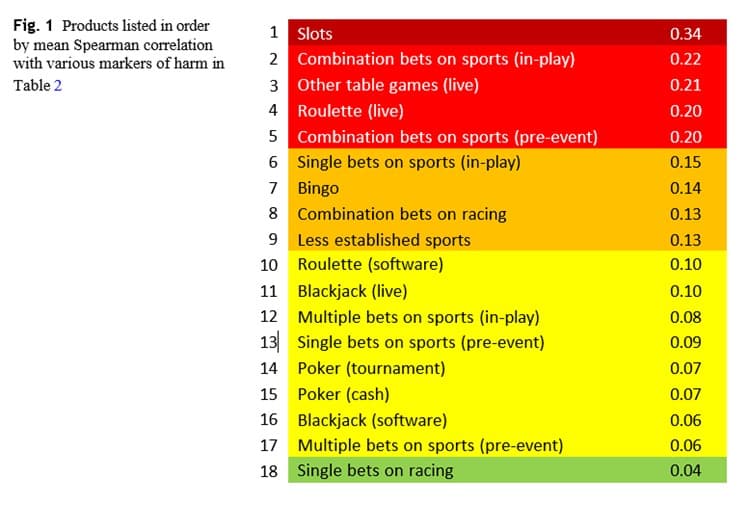- Casino
- By State
- Alabama
- Alaska
- Arizona
- Arkansas
- California
- Colorado
- Connecticut
- Delaware
- Georgia
- Florida
- Hawaii
- Idaho
- Illinois
- Indiana
- Iowa
- Kansas
- Kentucky
- Louisiana
- Maine
- Massachusetts
- Maryland
- Michigan
- Minnesota
- Mississippi
- Missouri
- Montana
- Nebraska
- Nevada
- New Hampshire
- New Jersey
- New Mexico
- New York
- North Carolina
- North Dakota
- Ohio
- Oklahoma
- Oregon
- Pennsylvania
- Rhode Island
- South Carolina
- South Dakota
- Tennessee
- Texas
- Utah
- Vermont
- Virginia
- Washington
- West Virginia
- Wisconsin
- Wyoming
- By State
- Slots
- Poker
- Sports
- Esports
Exploring Behavioral Markers of Harm in Various Forms of Online Gambling
Numerous studies have been conducted using online gambling data sourced from operators to try to identify markers of harmful behavior in their customers

And this ongoing research is giving us an increasingly clear picture of the ways in which a given gambler’s behavior correlates with their overall risk profile and their exposure to harm.
Less is known, however, about how these markers might be used to identify specific products that pose higher inherent risks. Can we use data to determine whether certain games are associated with behavioral markers of harm more strongly than others? Understanding product risk is of fundamental interest to policymakers that decide on the approval of new products and features, or on what safer gambling standards should be applied to them.
I was fortunate enough to be among a small group of renowned research experts commissioned to study this topic in-depth, and our results were recently published in the International Journal of Mental Health and Addiction. I think you’ll find some of the details as interesting as I did.
What Risk Factors Should We Consider?
Our research focused on a number of behavioral markers of harm previously identified through other studies in this field, including:
1. Deposit Behavior (Frequency, Rejections, Etc.)
The frequency of deposits can give us some baseline context about the experience a gambler is having. A high deposit frequency may be an indication that a player is chasing losses or exhibiting another harmful behavior. Declined transactions meanwhile fall into two categories: those declined by the bank for lack of funds and those declined by the payment provider. The former might be a direct indication of financial depletion, while the latter could be a clue that the customer has lost control of their spending.
2. Within-session Top-ups
The totality of a customer’s transaction ledger shapes their specific risk profile, but in-session deposits appear to have a particularly strong correlation to disordered gambling. Players who top-up are typically in the middle of a losing session, and their ability to make objectively sound financial decisions may be impaired.
3. Bonus-seeking Behavior
Like other concerning transactional behaviors, increased bonus seeking may indicate that a player is suffering from withdrawal, has depleted their own funds, or is attempting to chase their losses. In studies of sports betting, for example, exposure to additional incentives and special offers have been linked to a subsequent increase in the riskiness of a customer’s choices and the amount they spend.
3. Easing Responsible Gambling Settings
Regulated gambling websites typically offer in-client controls that allow players to limit the investment they’re willing to make in time and/or money. Customers who loosen
these controls or remove them altogether may be acting impulsively or losing control of their ability to walk away from the game.
4. Gambling at Unusual Hours
We also analyzed the play across periods of time where less than 5% of the playing population was active. This “odd-hours gambling” is a tricky metric from which to draw meaningful conclusions, however. Is a sports bettor wagering on Russian table tennis at 4 am because they’re chasing losses from the evening’s football matches, or because they’re just winding down from their night shift at work?
All markers apart from easing/removing responsible gambling settings appeared to scale with the number of active days engaging in specific product types. These findings highlight the potential value of using such markers to differentiate the risk and potential harm associated with individual products, and this relationship allows us to use the Spearman method to seek out correlations between certain types of engagement and a customer’s overall risk profile.
Analyses were based on six months of data from a sample of 100,000 individuals drawn from the population of UK users on Unibet from January through June of 2022.
Slots Among the Riskiest Forms of Gambling
The answer to the initial question seems to be a clear yes. Our research indicates that frequent participation in some product categories was more strongly associated with the markers of gambling-related harm than others — specifically those with high availability, shorter event periods, and continuous opportunities to bet. These characteristics imply stronger associations between disordered gambling and products like online slots, in-play sports betting, and live-dealer versions of online table games.

Even through a less-empirical lens, these formats are generally understood to be riskier than others.
Slots stand out from other products by having the highest overall and weekly participation rates of all the games analyzed. This data point indicates that slots are responsible for the highest number of regular gamblers, and our research notes a strong correlation to all five markers of harm.
Slots players recorded some of the highest overall losses in the dataset, trailing only combination sports bettors in terms of average loss per customer. Bonus page visits were closely associated with slots play too, as were top-ups and declined deposits. Slot play also appears more likely than other products to transition from periodic to regular participation.
This result dovetails with previous research which finds an apparent correlation between regular slots play and gambling disorder. And it makes sense given the nature of the games themselves. Slot machines have low price points, very short event frequencies, and a type of continuous play that creates a greater likelihood of cognitive immersion and loss of control.
In short, slots players are more likely to lose track of their time and money than other gamblers.
Other Takeaways from This Study
Of the three categories of table games studied, roulette was both the most popular and the most closely associated with markers of harm.
The relative risk was especially high for the live-dealer versions of roulette and other table games, which was perhaps one of the surprises that emerged from this research. Despite having a rate of play that’s typically 2-3x slower than their simulated counterparts, these live-dealer games are more strongly correlated with markers of harm. Additional research is needed to understand exactly why this might be the case. Sports betting is another interesting one.
Previous studies have suggested that in-play betting appears to carry a higher risk to the customer than pre-match betting, and our research reinforces that notion. In-play betting is more dynamic, more instantaneous, and more likely to create spur-of-the-moment decisions than pre-match betting or other forms of wagering. Combination bets similarly appear to be riskier
due to the high operator margins and low win probabilities that are inherent to the format.
The Value of Online Gambling Data in Research
It’s worthwhile to highlight the ways in which research rooted in online gambling is improving our understanding of the risks across all games and channels.
The always-on access that powers online gambling has frankly rendered much of the existing guidance inadequate. Legacy risk scoring protocols like Gamguard and ASTERIG were validated largely on land-based products, and they therefore struggle to differentiate risk within narrow product ranges or modernized contexts. Regulators may find, for instance, that online games are universally scored as high risk because they’re available remotely, involve immediate payouts, and employ sounds and graphics within the gameplay.
Unlike in-person gambling, data related to online gambling is rich, reliable, and timestamped for reference. Some of the data points we can track online – like the number of days a customer spends gambling or the average duration of their sessions – are either impractical or downright impossible to gather in the brick-and-mortar setting. Online, however, we can have a perfect accounting of these factors.
Online gambling data also allows us to get more granular with our analysis of the industry than ever before, as every relevant interaction between the customer and the operator is logged in real time. With this level of insight, we can begin to differentiate risk factors between two different products, or even two different formats of the same product.
Our hope is to shed some increased light on the ways at-risk customers navigate the gambling environment. Researchers like myself and my colleagues in this study all share the goal of making the industry safer, more sustainable, and less harmful to those who expose themselves to its risks. And the quality of the data at our disposal in this modern era is helping us improve the ways we prevent, detect, and treat gambling-related harm.
Related Topics:
Maris Catania is a gambling industry veteran, with more than fourteen years of game integrity and safer gambling experience. Prior to joining SG:certified as a Senior Safer Gaming Consultant, Maris was Head of Responsible Gaming and Research at Kindred. Maris has a Diploma in Gambling Addiction Counselling and Psychology, Msc in Psychology and has a PhD focusing on consumer protection, markers of harm, and responsible gambling, at Nottingham Trent University under the guidance of the leading distinguished Professor Mark Griffiths.
Must Read
Insider
May 15, 2025
Joshua Gamble: “Cross-sell is dead. What next?”
More Articles




Casino
June 30, 2025
Hard Rock Executive Under Fire Due to Alleged Misdeeds

Business
June 24, 2025
The Star Overhauls Team with Multiple Appointments

Industry
June 19, 2025
ICRG picks Michael Soll as New President














